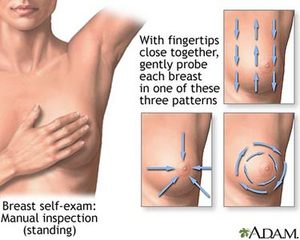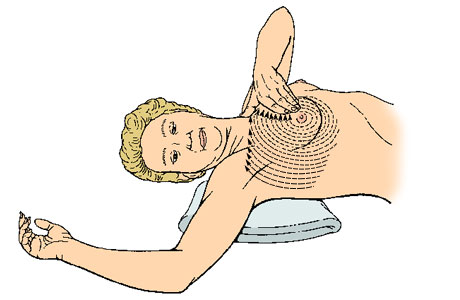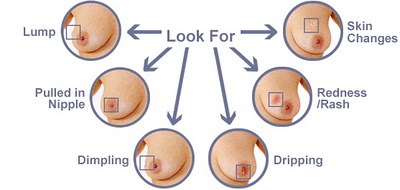According to the American Cancer Society, there will be an estimated
1,688,780 new cancer cases and 600,920 cancer deaths in 2017. That is 4,630 new cases and 1,650 deaths every day or 3 new cases and 1 death every minute. Breast cancer is the second most common cancer and the second leading cause of cancer death in women. Because early detection is critical to increasing your changes of survival after a cancer diagnosis, a monthly breast self exam is an easy and free method of screening.
Every woman has some lumps or bumpy areas in their breasts at all times, so do not panic if you think you feel a lump. Only 20% of women who have a lump biopsied are diagnosed with cancer. What is important about the self exam is that you get to know the look and feel of your breasts. Different areas of your breast will feel different. For example, the upper and outer area (near your armpit) will have more prominent lumps and bumps, the lower half of your breast can feel sandy while another part may feel more like a lumpy bowl of oatmeal.
Exams should be performed once a month, either a few days after your period or, if menopausal, performed on a day that will be easy to remember. After establishing a baseline for your breasts, you can easily detect any new lumps or increases in size of already identified ones. It can be hard to remember what you feel from month to month so keeping a journal or documenting your findings is a good idea. It is typical for lumps to appear at certain times in your cycle so it is the changes that last beyond a month or seem to get more prominent that are of concern. Report any of these changes to your health provider immediately.
The exam can be performed in three different positions.
1) In the Shower
Using the pads of your fingers, move around your entire breast in a circular pattern moving from the outside to the center, checking the entire breast and armpit area. Check both breasts for any lump, thickening, or hardened knot.
2) In Front of a Mirror
Visually inspect your breasts with your arms at your sides. Next, raise your arms high overhead. Look for any changes in the contour, any swelling, or dimpling of the skin, or changes in the nipples. Next, rest your palms on your hips and press firmly to flex your chest muscles. Left and right breasts will not exactly match—few women’s breasts do, so look for any dimpling, puckering, or changes, particularly on one side.
3) Lying Down
When lying down, the breast tissue spreads out evenly along the chest wall. Place a pillow under your right shoulder and your right arm behind your head. Using your left hand, move the pads of your fingers around your right breast gently in small circular motions covering the entire breast area and armpit. Use light, medium, and firm pressure. Squeeze the nipple; check for discharge and lumps and then repeat for other breast.
If any changes are noted or lumps palpated you should be evaluated by your healthcare provider. This self exam does not replace a mammogram or clinical breast exam but will help with early detection of cancer.
Additional Resources:
http://www.nationalbreastcancer.org/breast-self-exam
http://www.breastcancer.org/symptoms/testing/types/self_exam



